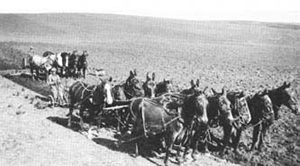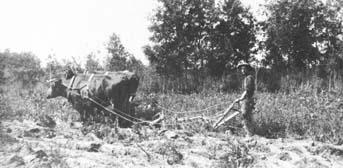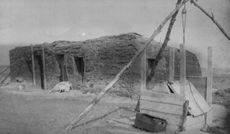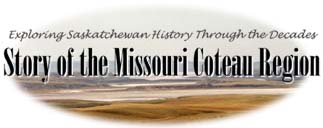 |
|
|
|||||||||||||||
Farmers generally could not afford the larger machinery so they had to rent it. Fifteen to sixteen men would come with the threshing unit. The farmer's wife was responsible to feed all the working men. If it rained the men would stay at the farmers house until the job was completed. The wife had to feed the men the entire time they were working on their homestead. A steam-powered thresher was used. The men pitched the stooks (small collection of sheaves) into the separator. Once the thresher was started the wheels would spin on a long rubber pulley. The men would help the farmer with all of the threshing operations. Once the threshing process was complete they would haul their crops to the elevators in Weyburn or Brooking by wagon or sleigh. It was very common for the elevator to be full already; the farmer would then have to go to McTaggart or Yellow Grass to unload their grain. In 1938 a new type of wheat, Thatcher, was developed that helped farmers a lot. This new type of wheat was rust resistant. All the farmers had to put up feed for their stock. To cut the hay they would use a mower equipped with a sharp blade and a sickle. Once the cut down hay had dried for a few days the bunches were pitched into haystacks.
Problems
Farmers faced a lot of problems. The wheat that they had was very slow to mature. The wheat wheat they had took a long time to mature so it was often hit with frost and frozen before it was ripe. The crops were prone to several different types of plant disease. Also, the crop could not withstand hot, dry weather. Grasshoppers and army-worms caused a lot of damage for several years. They would eat the crops and gardens and homesteaders had no way to control them. Rust was a common problem, drying out the crops it affected.
Wheat rust is a parasitic fungus that would cause the
rust-infected leaves to die prematurely, causing a reduction in quality and yield of grain. Some of these crops were such a poor quality that they weren't good enough to use as chicken feed. The best thing to do with these infected crops was to simply burn them. Russian thistle created a huge problem for farmers; it spread rapidly and was hard to control. Farmers did not have chemicals to treat affected crops. Mosquitoes and flies were everywhere. To help keep the bugs away they would burn green grass to create smoke. They also tried to use gunnysacks as screens but these did not work as well.
Animals
Animals were widely used during the early 1900s. For those that could afford a few horses and a few head of cattle, farming was made a lot easier. Animals were very expensive. One ox cost $100, horses cost anywhere from $150-200 and mules would cost anywhere from $300-400.
Farmers used horses a lot. They were used for working the soil, pulling farming equipment, digging dugouts, moving dirt, moving houses and barns to different locations, and they were used as the main mode of transportation. Mules were also used on the farm. They preferred not to use mules because they were
very stubborn. Farmers used oxen as well, although not very many people could afford them. They used the ox to help pull the machinery. Almost every farmer had a cow. They used the cows for milk, butter, cream, and meat. They preferred not to, but if they absolutely had to they would use a cow to pull a wagon. With the advent of the gasoline engine small, affordable tractors flooded the industry. Tractors could work all day. Land used for feed and pasture could be seeded to grain.
Homes
When the pioneers came they had nothing to make houses out of so they made small sod shacks. These shacks were very simple, easy to keep clean, cozy, and didn't leak. The shack could be decorated with wallpaper or paint, and rugs or floors could be put in them if desired. When the railway came lumber was brought in and houses were constructed of wood.
Water
It took a homesteader days to dig a well. A certain process used while digging a well was generally followed by all homesteaders. A hole would be dug with a shovel until it reached a depth of eight or nine feet. Once it reached this depth a 'windlass' was built to finish digging the hole. A windlass was made up of a long rope wound onto a sleeve with a hand crank at the end. The action of using a windlass was similar to the use of a winch. One person would be at the bottom of the hole filling the pail, while another person would be at the top of the hole to empty the pail. This process was repeated until the hole was completed.

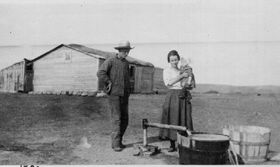


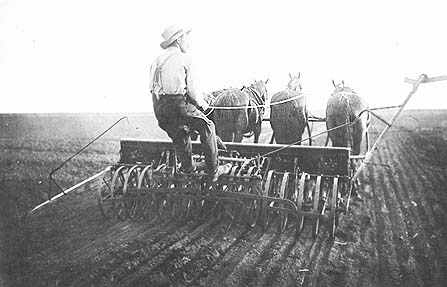
 Horse drawn binders were used to cut the grain and tie it into
sheaves or bundles. When the grain sheaves were dry and hard they
would rent a threshing unit.
Horse drawn binders were used to cut the grain and tie it into
sheaves or bundles. When the grain sheaves were dry and hard they
would rent a threshing unit. 